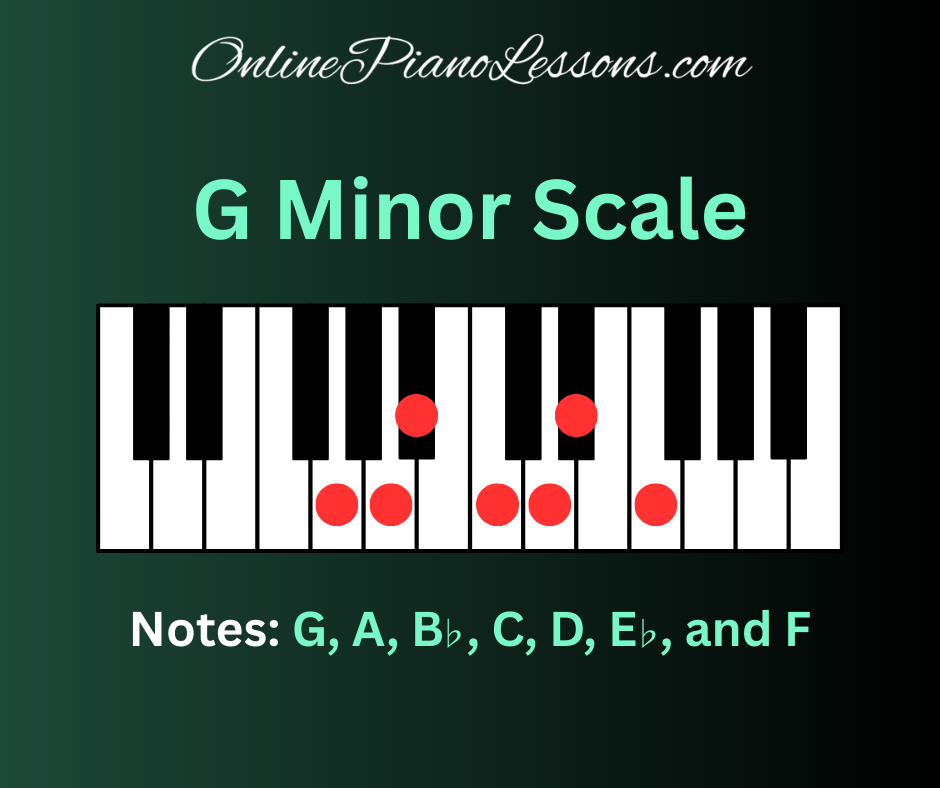
The g minor scale is a compact, expressive musical toolkit that crops up everywhere—from classical masterpieces to modern film scores and rock ballads. Darker than its relative major (B♭ major), the g minor scale is prized for its emotional weight and flexible tonal colors. This definitive guide covers everything: the three common forms (natural, harmonic, melodic), exact note spellings, piano fingerings, harmony and chords, practice routines, musical applications, common problems and fixes, and a short FAQ to wrap things up.
What is the G minor scale?
At its core, the g minor scale is any seven-note collection that starts and resolves on G and follows the interval pattern of a minor scale. It typically appears in three forms:
- G natural minor (the baseline form used for key signatures and basic harmony)
- G harmonic minor (raises the 7th degree to create a strong leading tone)
- G melodic minor (raises the 6th and 7th when ascending for smoother melodies; classical usage reverts descending)
Each form of the g minor scale has distinctive colors and uses. Knowing when to use which form is a major step toward sounding musical rather than mechanical.
Key signature and relatives
- Key signature: 2 flats — B♭ and E♭.
- Relative major: B♭ major (shares the same key signature).
- Parallel major: G major (different key signature and a brighter mood).
Because the g minor scale lives close to B♭ major on the circle of fifths, modulations between the two keys are common and easy to execute.
The notes — all three common forms
Here are the exact notes you need to know for the g minor scale.
G Natural Minor (Aeolian) — the default g minor scale:
G – A – B♭ – C – D – E♭ – F – G
G Harmonic Minor — raise the 7th (F → F♯):
G – A – B♭ – C – D – E♭ – F♯ – G
G Melodic Minor — raise the 6th and 7th ascending (E♭ → E, F → F♯); descend to natural minor in classical practice:
- Ascending: G – A – B♭ – C – D – E – F♯ – G
- Descending (classical): G – F – E♭ – D – C – B♭ – A – G
In jazz, the melodic minor is often used both ways, which unlocks a variety of modes (e.g., G Dorian ♭2 or G altered approaches via related modes).
Fingerings for the piano
Efficient fingering is the difference between slow, effortful scales and smooth, musical technique. Here are reliable two-octave fingerings that translate well between the natural, harmonic, and melodic forms of the g minor scale.
Right hand (RH) — two octaves, G natural minor
- Ascending: 1 – 2 – 3 – 1 – 2 – 3 – 4 – 5 (G A B♭ C D E♭ F G)
- Descending: reverse smoothly and evenly.
Left hand (LH) — two octaves, G natural minor
- Ascending: 5 – 4 – 3 – 2 – 1 – 3 – 2 – 1
- Descending: reverse the pattern.
The same patterns work for the harmonic and melodic variants; only the accidentals change (E♭ → E, F → F♯). Practice hands separately first, then hands together, and finish with contrary motion.
Chords and harmony inside G minor
Understanding the diatonic chords built from the g minor scale is essential for composition, improvisation, and analysis.
Diatonic triads in G natural minor:
- i — Gm (G–B♭–D)
- ii° — A° (A–C–E♭) — diminished
- III — B♭ (B♭–D–F)
- iv — Cm (C–E♭–G)
- v — Dm (D–F–A)
- VI — E♭ (E♭–G–B♭)
- VII — F (F–A–C)
Harmonic minor effects: raise F to F♯ — the V chord becomes D major (D–F♯–A) or D7, giving a powerful dominant that resolves to Gm. That raised 7th (F♯) is why composers use the g harmonic minor for strong cadences and tonal pull.
Melodic minor effects: ascending (with E natural and F♯) you get smoother melodic steps and additional color for major-leaning cadences or jazz-oriented chord substitutions.
Practice routines & exercises
Here are practical daily drills to make the g minor scale an integrated part of your playing:
10–20 minute focused routine
- Warm-up (2 min): One-octave G natural minor, hands separate, slow metronome (♩=60).
- Two-octave hands-separate (4 min): Focus on evenness and thumb-under smoothness.
- Two-octave hands-together (4 min): Straight rhythms, then dotted rhythms to iron out balance.
- Harmonic & melodic variants (4 min): One octave of G harmonic minor, then G melodic minor ascending — pay attention to raised notes.
- Musical application (2–6 min): Play a Gm–E♭–B♭–F vamp and improvise short phrases using G natural, then switch to harmonic and melodic colors.
Longer practice ideas: Try scales in thirds, parallel sixths, and contrary motion. Add arpeggios (Gm, D major, B♭) and chord-scale pairing (play a chord, then outline it with scale tones).
Musical uses and stylistic tips
- Classical music: Use g harmonic minor for cadences that demand a strong leading tone; use melodic minor for lyrical ascending lines.
- Jazz: The melodic minor and its modes (Dorian ♭2, Lydian dominant on related chords) are treasure troves for altered dominant sounds and modal interchange.
- Rock & pop: The g minor scale (often as natural minor or pentatonic) gives brooding riffs and emotive chord progressions; it’s guitar-friendly because of common chord shapes.
- Film & scoring: Composers use the g minor scale for scenes that require melancholy, tension, or dark romance.
Common problems and fixes
- Problem: Thumb bump at the pass-under.
Fix: Slow the crossing, keep the thumb close to the keys, and practice only the thumb-under motion in short bursts. - Problem: Raised accidentals feel foreign (E natural / F♯).
Fix: Isolate harmonic and melodic versions and play them repeatedly until the raised notes feel like choices rather than surprises. - Problem: Hands don’t align when moving hands-together.
Fix: Practice with one hand muted (or play RH while tapping LH rhythm) to train coordination, then bring the hands together slowly. - Problem: Tension at higher tempos.
Fix: Drop tempo and focus on relaxation — shoulders down, wrist supple, fingers rounded. Only increase tempo when the tone stays even.
Quick reference cheat sheet
- G natural minor: G A B♭ C D E♭ F G
- G harmonic minor: G A B♭ C D E♭ F♯ G
- G melodic minor (ascending): G A B♭ C D E F♯ G
- Key signature: 2 flats (B♭, E♭) — same as B♭ major.
Write these out on staff paper and play them daily — seeing and hearing the g minor scale together accelerates retention.
Famous works in G minor (listen while you practice)
- Mozart — Symphony No. 40 in G minor, K. 550 — one of the most iconic uses of G minor in the classical canon.
- Rachmaninoff — Prelude in G minor, Op. 23 No. 5 — a virtuosic piano piece that explores both the power and lyricism of G minor.
Listening to these pieces with the g minor scale in mind helps you hear how composers use natural, harmonic, and melodic forms to shape tension and release.
Final thoughts
The g minor scale is both practical and poetic. Mastering its natural, harmonic, and melodic forms gives you a versatile palette for composition, improvisation, and performance. Practice it slowly, use it musically, and apply it to real harmonic contexts — you’ll find the g minor scale becomes less of an exercise and more of a language for expressing mood, tension, and release
FAQ — G Minor Scale
Q1: What notes are in the G minor scale?
A: The g natural minor scale is G, A, B♭, C, D, E♭, F, G. The harmonic minor raises the 7th to F♯; the melodic minor raises the 6th and 7th ascending (E and F♯) and often reverts descending.
Q2: What is the key signature for G minor?
A: Two flats — B♭ and E♭. It shares this signature with B♭ major (the relative major).
Q3: Which form should beginners practice first?
A: Start with the g natural minor scale to learn the key signature and the basic chord shapes. Add harmonic and melodic variants after the natural form feels secure.
Q4: How does the G harmonic minor help with harmony?
A: Raising the 7th (F → F♯) creates a strong leading tone that turns the v chord (D minor) into a V major (D major) or V7, producing a powerful cadence that resolves to G minor.
Q5: How long until I feel comfortable with the G minor scale?
A: With consistent daily practice (10–20 minutes), your hands and ear will feel comfortable within a few weeks. Mastery that includes speed and musicality takes longer — keep the practice musical and applied.

 Get Full Access (Only $5/mo)
Get Full Access (Only $5/mo)



 I love playing piano, creating new melodies and songs, and further developing my online piano course and making updates/additions to my site OnlinePianoLessons.com!
I love playing piano, creating new melodies and songs, and further developing my online piano course and making updates/additions to my site OnlinePianoLessons.com!  Now that is what I call fun!
Now that is what I call fun!





